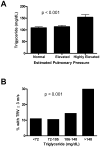Lipid levels in sickle-cell disease associated with haemolytic severity, vascular dysfunction and pulmonary hypertension
- PMID: 20230401
- PMCID: PMC3212812
- DOI: 10.1111/j.1365-2141.2010.08109.x
Lipid levels in sickle-cell disease associated with haemolytic severity, vascular dysfunction and pulmonary hypertension
Abstract
Pulmonary hypertension (PH) in sickle cell disease (SCD) is an emerging and important clinical problem. In a single-institution adult cohort of 365 patients, we investigated lipid and lipoprotein levels and their relationship to markers of intravascular haemolysis, vascular dysfunction and PH. In agreement with prior studies, we confirm significantly decreased plasma levels of total cholesterol, high-density lipoprotein-cholesterol (HDL-C) and low-density lipoprotein-cholesterol (LDL-C) in SCD versus ethnically-matched healthy controls. Several cholesterol parameters correlated significantly with markers of anaemia, but not endothelial activation or PH. More importantly, serum triglyceride levels were significantly elevated in SCD compared to controls. Elevated triglyceride levels correlated significantly with markers of haemolysis (lactate dehydrogenase and arginase; both P < 0.0005), endothelial activation (soluble E-selectin, P < 0.0001; soluble P-selectin, P = 0.02; soluble vascular cell adhesion molecule-1, P = 0.01), inflammation (leucocyte count, P = 0.0004; erythrocyte sedimentation rate, P = 0.02) and PH (amino-terminal brain natriuretic peptide, P = 0.002; prevalence of elevated tricuspid regurgitant velocity (TRV), P < 0.001). In a multivariate analysis, triglyceride levels correlated independently with elevated TRV (P = 0.002). Finally, forearm blood flow studies in adult patients with SCD demonstrated a significant association between increased triglyceride/HDL-C ratio and endothelial dysfunction (P < 0.05). These results characterize elevated plasma triglyceride levels as a potential risk factor for PH in SCD.
Conflict of interest statement
Figures



Similar articles
-
Association of pro-inflammatory high-density lipoprotein cholesterol with clinical and laboratory variables in sickle cell disease.Hematology. 2015 Jun;20(5):289-96. doi: 10.1179/1607845414Y.0000000171. Epub 2014 May 6. Hematology. 2015. PMID: 24801127 Free PMC article.
-
Levels of soluble endothelium-derived adhesion molecules in patients with sickle cell disease are associated with pulmonary hypertension, organ dysfunction, and mortality.Br J Haematol. 2005 Sep;130(6):943-53. doi: 10.1111/j.1365-2141.2005.05701.x. Br J Haematol. 2005. PMID: 16156864 Free PMC article.
-
Altered HDL particle in sickle cell disease: decreased cholesterol content is associated with hemolysis, whereas decreased Apolipoprotein A1 is linked to inflammation.Lipids Health Dis. 2019 Dec 20;18(1):225. doi: 10.1186/s12944-019-1174-5. Lipids Health Dis. 2019. PMID: 31861992 Free PMC article.
-
Pulmonary hypertension in sickle cell disease.Clin Adv Hematol Oncol. 2007 Aug;5(8):645-53, 585. Clin Adv Hematol Oncol. 2007. PMID: 17982405 Review.
-
Cardiomyopathy With Restrictive Physiology in Sickle Cell Disease.JACC Cardiovasc Imaging. 2016 Mar;9(3):243-52. doi: 10.1016/j.jcmg.2015.05.013. Epub 2016 Feb 17. JACC Cardiovasc Imaging. 2016. PMID: 26897687 Free PMC article. Review.
Cited by
-
Male gender, increased blood viscosity, body mass index and triglyceride levels are independently associated with systemic relative hypertension in sickle cell anemia.PLoS One. 2013 Jun 13;8(6):e66004. doi: 10.1371/journal.pone.0066004. Print 2013. PLoS One. 2013. PMID: 23785465 Free PMC article.
-
On artherogenic index of plasma in sickle cell anaemia patients.Pan Afr Med J. 2019 Mar 25;32:141. doi: 10.11604/pamj.2019.32.141.17166. eCollection 2019. Pan Afr Med J. 2019. PMID: 31308859 Free PMC article.
-
Lipid profiles in French West Indies sickle cell disease cohorts, and their general population.Lipids Health Dis. 2018 Mar 5;17(1):38. doi: 10.1186/s12944-018-0689-5. Lipids Health Dis. 2018. PMID: 29506549 Free PMC article.
-
Association of pro-inflammatory high-density lipoprotein cholesterol with clinical and laboratory variables in sickle cell disease.Hematology. 2015 Jun;20(5):289-96. doi: 10.1179/1607845414Y.0000000171. Epub 2014 May 6. Hematology. 2015. PMID: 24801127 Free PMC article.
-
The Worst Things in Life are Free: The Role of Free Heme in Sickle Cell Disease.Front Immunol. 2021 Jan 27;11:561917. doi: 10.3389/fimmu.2020.561917. eCollection 2020. Front Immunol. 2021. PMID: 33584641 Free PMC article. Review.
References
-
- Adedeji MO, Cespedes J, Allen K, Subramony C, Hughson MD. Pulmonary thrombotic arteriopathy in patients with sickle cell disease. Arch Pathol Lab Med. 2001;125:1436–1441. - PubMed
-
- Akinyanju PA, Akinyanju CO. Plasma and red cell lipids in sickle cell disease. Ann Clin Lab Sci. 1976;6:521–524. - PubMed
-
- Amarenco P, Labreuche J. Lipid management in the prevention of stroke: review and updated meta-analysis of statins for stroke prevention. Lancet Neurol. 2009;8:453–463. - PubMed
-
- Aslan M, Ryan TM, Adler B, Townes TM, Parks DA, Thompson JA, Tousson A, Gladwin MT, Patel RP, Tarpey MM, Batinic-Haberle I, White CR, Freeman BA. Oxygen radical inhibition of nitric oxide-dependent vascular function in sickle cell disease. Proc Natl Acad Sci U S A. 2001;98:15215–15220. - PMC - PubMed
-
- Ataga KI, Moore CG, Jones S, Olajide O, Strayhorn D, Hinderliter A, Orringer EP. Pulmonary hypertension in patients with sickle cell disease: a longitudinal study. Br J Haematol. 2006;134:109–115. - PubMed
MeSH terms
Substances
Grants and funding
LinkOut - more resources
Full Text Sources
Other Literature Sources
Medical

